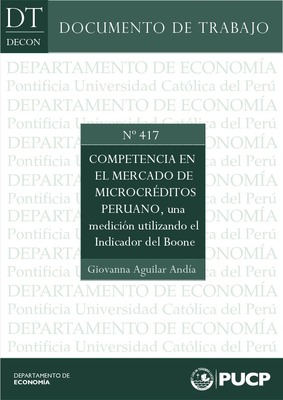| dc.contributor.author | Aguilar , Giovanna | |
| dc.date.accessioned | 2018-06-28T15:17:06Z | |
| dc.date.available | 2018-06-28T15:17:06Z | |
| dc.date.issued | 2016-03 | |
| dc.identifier.uri | http://repositorio.pucp.edu.pe/index/handle/123456789/126750 | |
| dc.description.abstract | Este estudio se analiza la competencia en el mercado microcrediticio peruano vinculándola con la eficiencia de las firmas involucradas y su participación en el mercado. El análisis se realiza para el periodo 2003 – 2009 utilizándose el Indicador de Boone, una medida más robusta de la competencia frente a otras medidas convencionales (IHH, Índice de Lerner). El análisis distingue los créditos otorgados a microempresas de los otros tipos de créditos (consumo, comercial e hipotecario), los que son tratados como un solo producto crediticio llamado créditos “otros”. Asimismo, en cada uno de los mercados de estos productos crediticios se identifican, siguiendo el criterio del valor del crédito promedio, subsegmentos de mercado y los tipos de operadores microfinancieros que en ellos compiten. Los resultados muestran que la competencia se ha intensificado en el mercado de créditos a microempresas, a pesar de observarse una mayor concentración en este mercado. Sin embargo, la competencia entre cajas rurales, financieras y EDPYMES es mayor que la existente entre cajas municipales y bancos especializados. En el mercado de créditos “otros” la competencia se ha intensificado entre cajas municipales y rurales mas no así, entre bancos y financieras.
This study examines competition in the Peruvian microcredit market linking it with the efficiency of the firms involved and their market share. The analysis is done for the period 2003 – 2009. The Boone Indicator is used since it is a more robust competition measure compared with conventional measures (HHI, Lerner Index). The analysis distinguishes microenterprise loans from other types of loans (consumer, commercial and mortgage) which are treated as a unique loan product called “others”. In each market loans were identified submarkets and types of microfinance operators following the average credit criterion The results show that competition has intensified in the microenterprise loans market, despite higher concentration observed. However, competition among rural banks, financial enterprises and EDPYMES is greater than between municipal banks and specialized banks. In the market of “others” credits, competition has intensified between municipal and rural savings but not so among banks and financial institutions. | en_US |
| dc.language.iso | spa | es_ES |
| dc.publisher | Pontificia Universidad Católica del Perú. Departamento de Economía | es_ES |
| dc.relation.ispartof | urn:issn:2079-8466 | |
| dc.relation.ispartof | urn:issn:2079-8474 | |
| dc.rights | Atribución-NoComercial-SinDerivadas 2.5 Perú | * |
| dc.rights | info:eu-repo/semantics/openAccess | es_ES |
| dc.rights.uri | http://creativecommons.org/licenses/by-nc-nd/2.5/pe/ | es_ES |
| dc.subject | competencia | es_ES |
| dc.subject | Indicador de Boone | es_ES |
| dc.subject | Microfinanzas | es_ES |
| dc.title | Modeling Latin-American Stock and Forex Markets Volatility: Empirical Application of a Model with Random Level Shifts and Genuine Long Memory | es_ES |
| dc.type | info:eu-repo/semantics/workingPaper | |
| dc.type.other | Documento de trabajo | |
| dc.subject.ocde | http://purl.org/pe-repo/ocde/ford#5.02.00 | |
| dc.publisher.country | PE | |
| renati.advisor.orcid | https://orcid.org/0000-0003-2031-5328 | |


